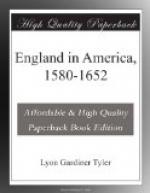In this state of affairs, deserted by their friends in England, the Maine settlements looked an inviting prey to Massachusetts. In October, 1651, three commissioners were appointed to proceed to Kittery to convey the warning of Massachusetts “against any further proceeding by virtue of their combination or any other interest whatsoever."[35] Godfrey declined to submit, and in behalf of the general court of the colony addressed a letter, December 5, 1651, to the Council of State of Great Britain praying a confirmation of the government which the settlers had erected. Cleves, at the head of the Rigby colony, made common cause with Godfrey and carried the petition to England, but he met with no success. The death of Rigby rendered Cleves’s influence of no avail against the Massachusetts agent, Edward Winslow, who showed that Cleves’s mission had originated among American royalists.[36]
This opposition, in fact, served only to hasten the action of Massachusetts. In May, 1652, surveyors were appointed by the general court who traced the stream of the Merrimac as far north as the parallel of 43 deg. 40’ 12".[37] Then, despite the protests of Godfrey, commissioners were again sent to Kittery, where they opened a court, November 15, and shortly after received the submission of the inhabitants.[38] They next proceeded to Gorgeana, where the like result followed, Governor Godfrey reluctantly submitting with the rest. Gorgeana was made a town under the Massachusetts jurisdiction, by the name of York, and all the country claimed by Massachusetts beyond the Piscataqua was made into a county of the same name.[39]
Next year, 1653, commissioners were sent to Welles, the remaining town in the Gorges jurisdiction, to summon to obedience the inhabitants there and at Saco and Cape Porpoise, in the Lygonian patent, and the conditions made resistance unlikely. Disregarding the Rigby claims,[40] the settlers in southern Maine accepted the overture of the Massachusetts commissioners. Accordingly, Welles, Saco, and Cape Porpoise followed the example of Kittery and Gorgeana, and came under the government of Massachusetts.
The inhabitants north of Saco about Casco Bay remained independent for several years after. Cleves and other leading inhabitants would not submit, and they tried to secure the interference of Cromwell. When they failed in this attempt, the people of Casco Bay, in 1658, recognized the authority of Massachusetts. It was at this time that the plantations at Black Point, at Spurwink, and Blue Point were united and received the name of Scarboro and those at Casco Bay received that of Falmouth.[41]
Whatever judgment we may pass on the motives of Massachusetts in thus enlarging her borders to the farthest limits of settled territory north of Plymouth, it must be acknowledged that her course inured to the benefit of all parties concerned. The unruly settlements of the north received in time an orderly government, while each successive addition of territory weakened the power of the religious aristocracy in Massachusetts by welcoming into the body politic a new factor of population.




